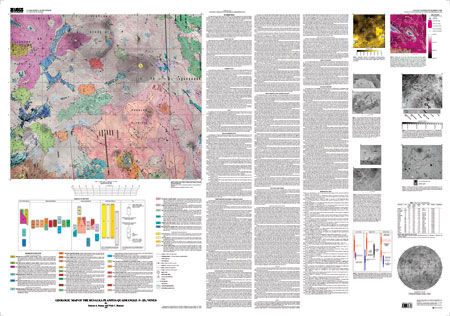


| INTRODUCTION The Rusalka Planitia quadrangle (herein referred to as V-25) occupies an 8.1 million square kilometer swath of lowlands nestled within the eastern highlands of Aphrodite Terra on Venus. The region (25º-0º N., 150º-180º E.) is framed by the crustal plateau Thetis Regio to the southwest, the coronae of the Diana-Dali chasmata complex to the south, and volcanic rise Atla Regio to the west. Regions to the north, and the quadrangle itself, are part of the vast lowlands, which cover four-fifths of the surface of Venus. The often-unspectacular lowlands of Venus are typically lumped together as ridged or regional plains. However, detailed mapping reveals the mode of resurfacing in V-25's lowlands: a mix of corona-related flow fields and local edifice clusters within planitia superimposed on a background of less clearly interpretable extended flow fields, large volcanoes, probable corona fragments, and edifice-flow complexes. The history detailed within the Rusalka Planitia quadrangle is that of the extended evolution of long-wavelength topographic basins in the presence of episodes of extensive corona-related volcanism, pervasive low-intensity small-scale eruptions, and an early phase of regional circumferential shortening centered on central Aphrodite Terra. Structural reactivation both obscures and illuminates the tectonic development of the region. The data are consistent with progressive lithospheric thickening, although the critical lack of an independent temporal marker on Venus severely hampers our ability to test this claim and correlate between localities. Two broad circular basins dominate V-25 geology: northern Rusalka Planitia lies in the southern half of the quadrangle, whereas the smaller Llorona Planitia sits along the northwestern corner of V-25. Similar large topographic basins occur throughout the lowlands of Venus, and gravity data suggest that some basins may represent dynamic topography over mantle downwellings. Both planitiae include coronae and associated lava flows, as well as fields of volcanic shields. Within each basin, the local geologic histories are relatively well constrained; correlations between the planitiae are difficult without making assumptions. The region between the two basins contains large volcanoes, corona fragments, deformation belts, and shield fields embedded within a topographically higher heterogeneous expanse of rolling plains. V-25's most prominent structural grain is a suite of wrinkle ridges that arc around the southwest corner of the quadrangle. A patchy suite of northeast-trending assorted lineaments underlies much of the map area. Although these lineaments originally were narrow fractures, this structural suite appears to have subsequently opened up along extensional troughs near Corpman crater in the southwest corner of the map area and been reactivated as wrinkle ridges at Ran Colles in the middle of the southern boundary of V-25. Nineteen impact craters dot the quadrangle. Craters Yazruk, du Chatelet, and Caccini contribute large geology- obscuring ejecta halos. Crater densities are too low for either relative or absolute age dating. Ten splotches, presumably associated with meteor airbursts, also occur across V-25. |
Download this map as a PDF document (60 x 42 inches; 46 MB)
Download a current version of Acrobat Reader for free
| Help | PDF help | Geopubs main page | Other Planetary Maps |
| Privacy Statement | Disclaimer | Accessibility |
| Geologic Division | Astrogeology Research Program |
This map is also available from:
USGS Information Services, Box 25286,
Federal Center, Denver, CO 80225
telephone: 303-202-4210; e-mail: infoservices@usgs.gov